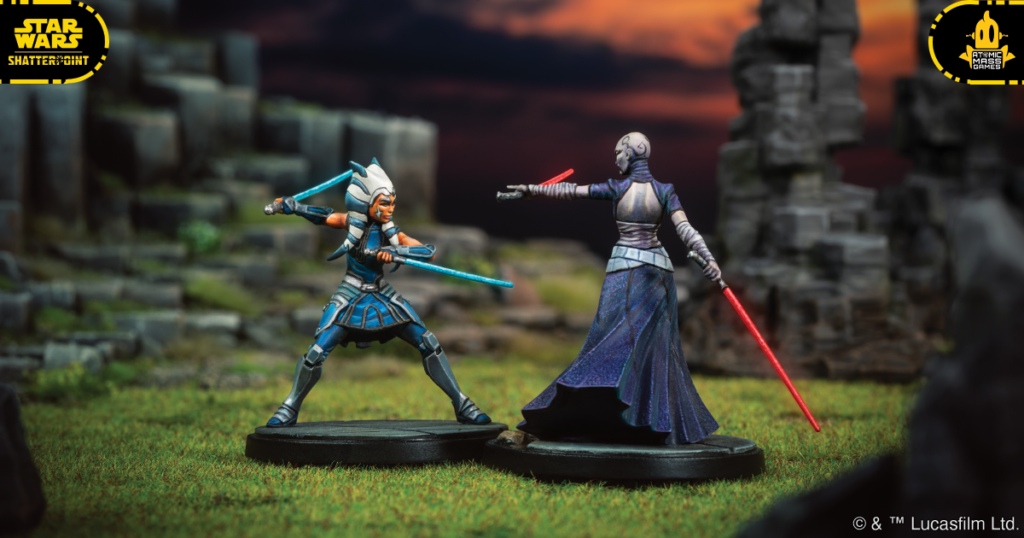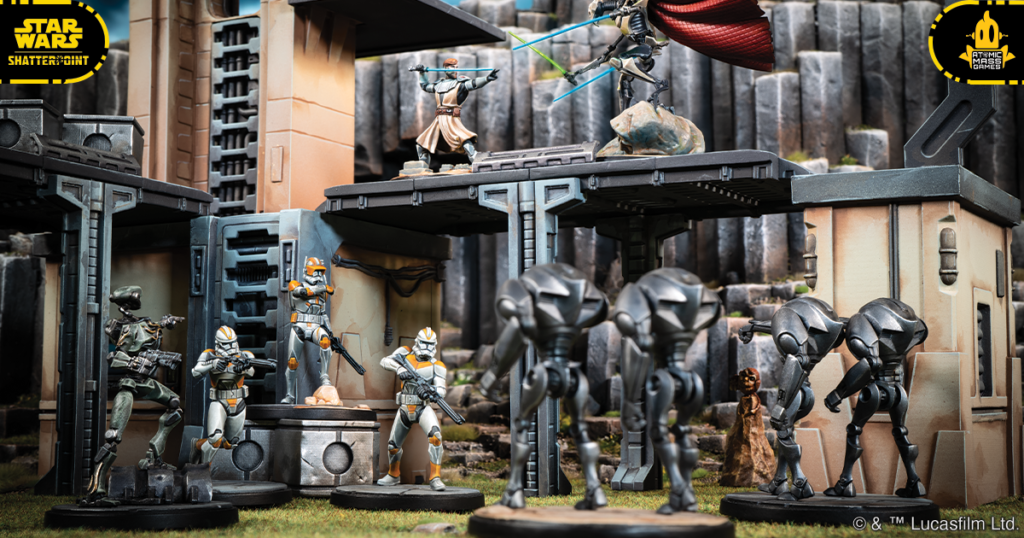Why We Made STAR WARS™: Shatterpoint
02/06/2023In Star Wars: Shatterpoint, iconic characters from across the galaxy clash in this new miniatures skirmish game. Coming Summer 2023!

In today’s transmission, we rounded up Will Shick (Head of Product Development), William Pagani (Development Manager), and Michael Plummer (Game Developer) to give you some key insights on our studio’s goals for Star Wars: Shatterpoint and how the game has inspired us to bring our vision to life on your table.
When we sat down to create Star Wars: Shatterpoint, we knew there was room for more play experiences within the Star Wars universe.
“While we have incredible Star Wars games that cover the gamut of big starship battles, starfighter dogfights, and army scale engagements with Armada, X-Wing, and Legion, it was very important for us to create a game experience that truly captured the pivotal conflicts between small iconic groups of characters within these greater battles that we often see on screen,” said Shick.
AMG’s second goal was to create a unique entry to miniatures skirmish games. William Pagani explained specifically that Shatterpoint “utilizes a distinct system for how and when units activate. The struggle objective system gives a sense of building tension and payoff as the game progresses creating a very on-edge and unique miniature gaming experience.”
Plummer wanted to keep players engaged via changing circumstances, making Shatterpoint “a game that is always posing the players with interesting questions. From the moment a player starts building their strike team – all the way through the final struggle, players will need to weigh their options carefully and adjust their plans on the fly if they want to emerge victorious.”
So where do you start when it comes to creating a game like that? As with most things designed by AMG, the process began with Shick and Pagani locked in a room to hone in on how best to execute a game centered on the narrative of fighting in Star Wars. They decided that combat shouldn’t just be about dealing damage, but about using your abilities to claim objectives under fire, drive back your opponent, and create openings for the rest of your strike team – all while using the environment to your advantage. After a few weeks of discussion, they had initial design documents and development with the rest of the team began.
Plummer was excited to join in the design process. “We would play games and have discussions around our feedback. Then we would come up with new mechanics to try the next day. There is always so much freedom to share ideas when working with this team, and we do our best to learn something from every iteration of what we make.”
Shick reflected with pride on the collaboration. “To be able to see the influence and input of each member of the team and how they all come together to create this amazing thing called Shatterpoint is really special – because none of the characters would feel right without all the parts fitting together just so.”
While all three AMG team members celebrated the collective work put in by the studio, Shick, Pagani, and Plummer all had elements they championed during the process.
Pagani wanted to create something that showcased the themes of hope and struggle – with “combat trees, board manipulation of attacks and abilities, and a struggle mechanic” that charts the players’ course to victory. All these elements capture the feeling of fighting a life or death battle with your back to the wall.
While Pagani was focused on distilling the essence of these character-driven struggles into mechanics, Plummer was excited to ensure the characters felt faithful to the source material. “I wanted the game to evoke the kind of excitement that I felt pretending to be Luke Skywalker™ as a kid. I want people playing the game to nod their heads and say ‘Yes, THAT is Ahsoka Tano™!’”

Shick wanted the game to create the excitement of iconic character driven storytelling within amazing environments. “It’s about the excitement we feel when we watch Asajj Ventress™ and Obi-Wan Kenobi™ crossing lightsabers while precariously balanced on a collapsing gantry. I wanted players to feel the pressure of heavy blaster fire as their squad ducked and dodged for cover while feeling the desperation of slowly being driven back from their key objectives and having to come up with some unconventional heroics to pull victory from the jaws of defeat.”
The mechanics of Shatterpoint sing with the visual elements of the game. Shick espoused that the visual style centered on “keeping that animated, kinetic adventure feel we wanted the core of the game to express – and one that would be inviting for players to experience at all levels of the hobby.”
Plummer also celebrated the work of our art and sculpting directors at AMG. “The highly stylized art and miniatures evoke the feeling of high-action animated cartoons – and a galaxy where Jedi leap the height of entire buildings while under fire from the incessant barrage of encroaching B2 Battle Droids.”
Of utmost importance was honoring the characters from Star Wars that we know and love. “We are very dedicated to maintaining each character’s personality and unique traits, drawing inspiration from our favorite moments in the movies and TV shows to make sure that every Unit in Shatterpoint is both well-tuned for game balance and absolutely dripping with thematic appeal,” said Plummer.
Mechanically, “characters in Shatterpoint are expressed through their abilities and their combat stances,” Shick explained. “The abilities show the character’s talents, powers, and leadership which come together to give the foundational feel for the character as we see them on screen. How combat style is expressed through each character’s Combat Stance really brings out the narrative feel and their individual personality.” He provided further insight for players saying, “Lord Maul’s™ combat stances showcase an extremely aggressive and dangerous character who is focused on the destruction of his enemies above all else. While Obi-Wan’s™ combat tree is less about raw damage and more about manipulating positioning and exposing his opponent, wearing them down and setting them up to suddenly find themselves out of position to claim a critical objective.”

In addition, Shick shared that he’s thrilled to see Shatterpoint add some new takes on classic concepts that he hopes “will open up miniatures games to a whole new group of people who may not necessarily have found a right fit with previous miniatures games.” He added that for existing miniatures game enthusiasts “it brings a whole lot of interesting and different tactical challenges for them to figure out.”
The development of this game has been a years-long process and there are certain points that excited and inspired the team to forge ahead through challenging times. Pagani considered the breakthrough of how to get the moving and changing objective system to work a big turning point for him. “It is an innovative system that hasn’t really been done before in tabletop gaming and that is always exciting!”
Shick agreed. “It really drove us to think about mechanics in really unusual ways. It was fun to throw out a lot of the common playbook on what is expected from miniatures games and reshape and innovate to create something that expresses a lot of those core things in new and different ways.”
Plummer added that for him, the most exciting moment was seeing the physical proofs of the game come in after only seeing the art and rules on screens for so long. “Seeing it all together in one place really hit home for me how amazing it has been to work on this game with this team – and the end result is just beautiful to look at.”
Shick’s most rewarding moment was seeing the game connect with playtesters that were new to skirmish games who seemed to catch on to Shatterpoint quickly. “ It was so exciting to see that flash spark across their eyes as they got it and then really got into the game experience. That moment when it stops being a mechanical exercise and becomes something so much more personal and profound is really incredible to watch and something you always strive for in game design.”
“I think that making Shatterpoint has really brought us together as a studio in a lot of meaningful ways. People from every department have been generous with their time for internal playtesting, everyone is always excited to see the newest miniatures or a new piece of art – the excitement around the office is electric,” said Plummer.
Thanks so much for joining us for this behind the scenes look at Star Wars: Shatterpoint. Keep an eye out for more behind the scenes insights and game mechanics articles over the next two months.